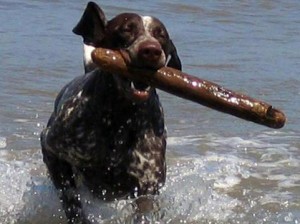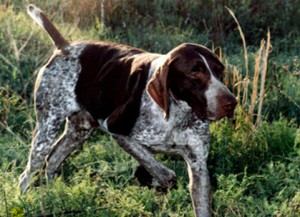Judging the German Shorthaired Pointer
Submitted by the German Shorthaired Pointer Club of America
Judging the GSP should be simple because the breed is not extreme and does not place emphasis on one or two specific attributes. It is first and foremost an athletic, hard working gun dog and should be considered as such when its structure and movement are being evaluated. A medium sized breed, the Shorthair should be balanced front and rear with every aspect of its structure carefully thought out for it to do the multiple jobs for which it was developed.
Temperament is utmost important for a dog to work well with people and other dogs. They should exhibit confidence, intelligence and a willingness to please. In the field they should show a keen enthusiasm for work, with assertive, bold and forward movement. Confident dogs will not exhibit nervousness, tucked tails or be shy. In the show ring look for the confident dog moving with a purpose.
Fault finding when judging potential breeding stock is non-productive both in the ring and in the whelping box; rather look for the positives, i.e. breed type and soundness when moving. As you view the whole dog, look for size, balance and proportion. Is the bone in proportion, does the headpiece fit and correct for the dog’s sex? Note length of neck and legs in proportion to the body. Does it have a short firm back, correct tail set, tight feet, well let down hocks and is the dog in good condition? Underline and top line should not be parallel even on the dog that is slightly longer than tall. There should be a slight slope from the base of the tail up to the withers and the coat should feel harsh to hand.
The Head section of the Standard contains a lot of information but the GSP is not a “head” breed, rather the attributes in this section are to produce a functional head with distinctive breed type. You are not looking for planes or boxes, descriptive terms in other sporting breed standards. The stop affect is created by eyebrow placement and not within the bone structure. Every aspect of the head was carefully thought out for a breed that is to scent and locate game, work in heavy cover and to grasp, hold and carry game over distance.
Note the eye shape, color and expression in addition to the ear set that should be just above the eye level. Using your hands check the top of the reasonably broad skull for a slight roundness, it should not be domed or flat. Slide your fingers down the side of the head to feel the arched area, another area that should not be flat. The distance from the end of the nose to the foreface and from there to back of the skull should be approximately the same. Dogs lacking under jaw will lack depth of muzzle in relation to its length. Look for harmonious proportions; does the muzzle fit the skull and vice versa? Note the stop is not found within the bone structure rather an illusion created by eyebrow placement.
The ear is set slightly above the eye, broad across the top and taper to a slightly rounded end. It should frame the face but not hug like a tied scarf, nor should it stand away or hang in folds. Lay the ear forward and without being stretched the tip should reach the corner of the mouth.
As you look at the eye, you should see a medium size almond shape with close fitting rims and lids. If it is light in color as may be the case in some young dogs, check for a dark ring at the outer edge of the iris. If there, the eye should darken as the dog ages with some taking up to two or three years to achieve the adult color. Light eyes without the dark ring will not darken with age. Some puppies will have dark iris color that will remain as they age into their adult years.
The nose should be large, dark brown and broad, as if looking at the end of a double barrel shotgun.
The correct bite is scissor with molars properly intermeshing but teeth aren’t counted. Extreme over or undershot is a DQ and a muzzle that is too short or is lacking depth will affect a dog’s ability to pick up and carry game over distance.
The neck tapers at the nape and widens slightly as it blends into the shoulder. There should be sufficient length of neck for the dog to pick up and retrieve game but not so long it will tire over distance. Does the shoulder blade lay back and on the rib cage blending smoothly? The upper arm should be long returning back in a compliment angle placing elbows in a support position along side the rib cage. The area just behind the elbow will be slightly smaller in circumference than a hand’s width back allowing the elbow to work and stay under the dog for balance during movement.
The pro-sternum should have proper fill in older dogs. Note depth of chest, at least to the elbow and adequate length of ribcage with slight spring not width thus allowing adequate heart and lung function. The back is short and strong with a perceivable slope from the withers to the base of the tail and a perceivable rise from the bottom of the chest up and into the tuck up. Neither is exaggerated, but some dogs with level top lines or rears higher than their withers may be stacked with the rear quarter stretched well out behind to give the impression of a sloping top line.
The Standard allows for square or slightly longer than tall dog, the latter does not mean a long bodied dog with short legs. A slightly longer than tall dog will still be in proportion whereas the one with a long body with short legs will not. The term short back standing over a lot of ground is based on a well laid back shoulder blade and a complimentary forward tilt of the sacrum (pelvis) with forequarter angles matching hindquarter angles. Imagine a trapezoid superimposed on the side of the dog with the sidelines running through the middle of the shoulder blade and pelvis. The parallel lines above and below indicate the short back standing over a lot of ground.
Dogs with balanced front and rear angles will have a smooth ground covering stride with little effort expended thus allowing it to work longer while holding a firm top line. One should see extension from the shoulder, not lifting at the elbow or hackney at the pastern. The rear leg should extend behind but rear feet kicking up and the hock lifting in a piston motion creating a bicycle or paddlewheel motion out behind the body provide very little forward propulsion. Upright blades and short upper arms restrict forward reach and if set to far forward on the ribcage limit the dogs’ ability to balance and transfer weight efficiently while moving
Viewed from the front one should be able to see depth of chest with slight rib spring. The legs should be parallel with the elbows back under the dog, they should not appear to originate from the same place nor should the elbows “wing” out away from the body. As the dog moves one should see clean forward movement.
Viewed from behind, the upper thigh and second thigh should be approximate in length and appropriately muscled on both the inside and out. The hock should be well let down neither turning in or out while the dog is standing or moving. As the dog comes up to speed it is desired to single track.
The tail is an extension of the spine and used as rudder for balance on both land and in the water while the dog works. Tails set too high or low because of a dropped off croup will not move efficiently and tire sooner. The length of the tail is man made and should not factor into the overall evaluation of the dog’s conformation.
A GSP’s feet should be tight with sufficient arch in the toes, not flat or splayed, they may be round or spoon shaped and webbed. There should be good depth of pad to cushion and protect while working long hours, over rough terrain or in areas known for sand burrs, thorny brush and rocky soil. Their nails are heavy and tough and should not be guillotined back to the end of the toe. Nails should be trimmed to a length that allows the foot traction without slipping but not so long as to cause the toes to turn sideways or the feet to spread.
There is no preference for a specific coat pattern or head marking, while you may prefer one as opposed to another please do not let that factor into your decision when evaluating structure and efficient movement. Do keep in mind light comes forward and dark recedes. You may have two dogs and or bitches with the same exact structure that may not appear that way because of their coat pattern or head marking. This is why it is important to put your hands on the dogs. The liver color may vary from very dark like bittersweet chocolate to lighter shades. The liver GSP is genetically “bb”. It is important to understand regardless of darkness of color, the nose pigment will be liver and there are no black hairs intermingled with the liver color to make the ticked and roan areas look darker.
The white Piebald and extreme white Piebald coat pattern has been in the breed since the very first dog Hecktor I was registered in the German Studbook in 1879. Judges should view dogs with this coat pattern no different than their solid liver, liver patched, roan or ticked counterparts.
Judge the total package do not get caught up with a personal color or coat pattern preference. Let movement be the deciding factor if two dogs are very close in positive attributes to the Breed Standard. Always keep in mind this is a hard working gun dog bred for multiple purposes. Type and soundness should always be foremost.
Short URL: http://caninechronicle.com/?p=41509
Comments are closed













